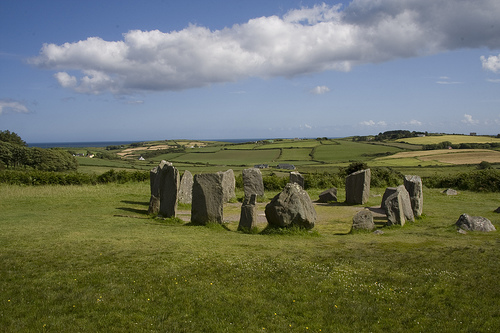

Location: 2.4 km (1.5 miles) East of Glandore, County Cork Map
Constructed: c. 945 - 830 BC
Drombeg Stone Circle, located in County Cork, Ireland, is one of the most well-preserved and visited stone circles in the country. Known locally as the “Druid’s Altar,” it dates to the Late Bronze Age, likely between 1100 and 800 BCE, and offers a fascinating glimpse into prehistoric ritual and astronomical practices.
Drombeg Stone Circle is situated on a terrace overlooking the Atlantic Ocean, near Glandore and Skibbereen in West Cork. The site lies on a gentle slope with panoramic views of the rugged coastline, creating a dramatic and serene backdrop. The circle is part of a broader archaeological landscape, with other ancient monuments like fulachtaí fia (prehistoric cooking pits) and hut sites nearby. Its coastal position and alignment suggest it was deliberately placed to connect with the natural environment and celestial events.
The stone circle measures approximately 9.3 meters (30 feet) in
diameter and originally consisted of 17 standing stones, of which 13
remain upright today. The stones are local sandstone, varying in height
from about 0.6 to 2.1 meters (2 to 7 feet), with the largest being the
axial or recumbent stone. Key features include:
Axial Stone: The
recumbent stone, lying flat on the southwest side, is a hallmark of
Irish stone circles, particularly in Cork and Kerry. It is 2.1 meters
long and aligned with the circle’s axis, likely serving as a focal point
for rituals or astronomical observations.
Portal Stones: Two taller
stones, each about 1.8 meters high, stand opposite the recumbent stone
on the northeast side, forming an entrance or “portal” into the circle.
These create a visual axis across the circle.
Symmetry and Alignment:
The stones are arranged in a slightly oval shape, with careful attention
to symmetry. The circle’s axis aligns with the winter solstice sunset,
which sets over a notch in the distant hills, indicating an astronomical
function.
Central Pit: Excavations revealed a pit at the center
containing cremated human remains, suggesting the site was used for
burial or ritual offerings.
The stones are smooth and rounded, likely
shaped by natural weathering or human effort, and their arrangement
reflects a sophisticated understanding of geometry and landscape.
Drombeg was excavated in 1957 by archaeologist Edward Fahy, yielding
significant insights into its use:
Central Burial: A pit at the
circle’s center held a pot containing cremated remains, dated to around
1100–800 BCE. The presence of human ashes suggests a funerary or
sacrificial role.
Fulacht Fia: About 40 meters from the circle, a
fulacht fia (a stone-lined cooking pit) was uncovered, complete with a
hearth, well, and trough. This feature, common in Bronze Age Ireland,
was used for heating water, possibly for cooking, bathing, or ritual
purposes. Charcoal from the site was radiocarbon-dated to the same
period as the circle.
Hut Sites: Nearby circular hut foundations
indicate Drombeg was part of a small settlement. These huts, about 4–5
meters in diameter, likely housed a community that maintained the
circle.
Artifacts: Few artifacts were found, but the pottery sherds
and cremation urn suggest domestic and ritual activities overlapped.
The absence of significant wear on the stones and the careful placement
of features point to Drombeg being a well-maintained ceremonial site.
Drombeg’s alignment with the winter solstice sunset is a key feature,
linking it to other Irish monuments like Newgrange. On December 21, the
sun sets over the recumbent stone, framed by the portal stones and a
distant hill, suggesting the circle was used to mark seasonal cycles,
possibly for agricultural or spiritual purposes. The solstice alignment
may have symbolized renewal or the return of longer days, critical for a
farming community.
The central burial and axial stone indicate
Drombeg was a ritual site, possibly for ancestor worship, fertility
rites, or community gatherings. The recumbent stone, common in southwest
Ireland, may have represented a threshold between the living and the
dead or the earthly and cosmic realms. The nearby fulacht fia could have
supported communal feasting or purification rituals, reinforcing the
site’s role as a social and spiritual hub.
Drombeg belongs to a regional tradition of recumbent stone circles
found in Cork and Kerry, distinct from larger circles like Stonehenge.
These smaller circles, built by Bronze Age communities, reflect a
localized culture with ties to the landscape and sky. The people who
constructed Drombeg were likely pastoralists and early farmers, using
the site to reinforce social bonds and cosmic order.
The circle’s
nickname, “Druid’s Altar,” is a later romantic attribution, as Druids
(Iron Age priests) postdate the circle by centuries. However, the name
reflects the site’s enduring mystique in local folklore. In the 19th and
20th centuries, antiquarians and early archaeologists speculated about
its purpose, often linking it to pagan worship or astronomy, ideas that
modern archaeology has partly validated.
Drombeg is maintained by Ireland’s Office of Public Works and is open
to the public as a National Monument. Its accessibility and scenic
location make it a popular destination for tourists, historians, and
those interested in ancient spirituality. The site remains largely
intact, though some stones have weathered or fallen, and the surrounding
landscape has changed due to modern agriculture.
Visitors often
note the circle’s tranquil yet powerful atmosphere, heightened by its
coastal setting and solstice alignment. It continues to inspire artists,
writers, and researchers, serving as a tangible link to Ireland’s
prehistoric past.
Access: The site is free to visit, with a small parking area and a
short path leading to the circle. It’s signposted off the R597 road
between Glandore and Rosscarbery.
Best Time: Visiting during the
winter solstice allows observation of the sunset alignment, though the
site is striking year-round. Early morning or late afternoon offers the
best light and fewer crowds.
Nearby Sites: Other stone circles, like
Bohonagh and Reanascreena, are within a short drive, as are coastal
attractions like Glandore Harbour.